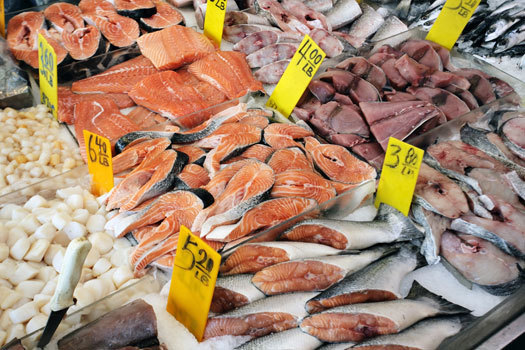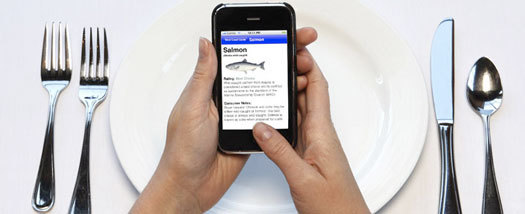
August 11, 2009
Fish Systems and Design
 Fish Market, with permission from Shutterstock.
Fish Market, with permission from Shutterstock.
Although important in raising awareness, the danger with films like The End of the Line (as with An Inconvenient Truth, and Michael Pollan’s Food, Inc.) is that they bombard us with so much bad news that positive and practical actions, that are also being taken, are obscured and opportunities to help them develop are missed.
The End of the Line received far more publicity, for example, than the launch of FishChoice.com. This free, non-profit site helps chefs and retail buyers procure sustainable seafood from suppliers accredited by leading ocean conservation organizations. FishChoice partners include the Marine Stewardship Council, The Monterey Bay Aquarium and the Blue Ocean Institute.
FishChoice.com is one of many business-to-business (B2B) innovations that begin to unlock an intractable problem: how to reconfigure food systems that lock their participants into ecocidal behavior. It’s not as if fishermen, wholesalers, food processing firms, retailers, chefs and consumers want to destroy the world’s fisheries. Yet the linear structure of the supply and communication chains they operate in prevents them from seeing and responding appropriately to the bigger picture. For food systems to be resilient we need to radically reconfigure relationships between fishers and consumers. We need to measure what matters throughout the lifecycle of fish, turn supply chains into supply webs or ecologies and put in place new, transparent economic relationships between fishers and citizens.
This is easy to say, hard, in practice, to do. I received the Fish Choice press release on market day where I live in France, and I soon found myself at my regular independent fish stall. The friendly couple who run it told me what tasted best that day, but information about the fish on the table before me was otherwise minimal. Hand-written tags told me things like “Cod, North Atlantic” and a price per kilo. But I was given no idea where the fish came from, how or when it was caught, by whom or what has happened to it since then. In the language of system design, I was an “actor” at a “touch point” at the end of a “chain of custody” running from the fishing vessel to the dock, from the dock to a processor or wholesaler and from there, in this case, to my fishmonger. In the language of stating the obvious, I was buying blind.
 Consumer guide to buying fish. Photo: John Thackara
Consumer guide to buying fish. Photo: John Thackara
I do carry around a credit card sized consumer guide to buying fish (above) published by the World Wildlife Fund. It divides fish into “preferred,” “buy in moderation” and “avoid.” I use the leaflet in restaurants where one can consult it discreetly whilst reading the menu. But standing in front of my cheerful fishmonger with a queue of people behind me, I did not. It’s too small and fiddly to read easily, the names of fish listed by the WWF do not always correspond with the words on the plastic tags and above all, I was not at all sure I possessed the social tact to engage the friendly fishmonger in a non-confrontational way.
 Seafood Watch app. Photo: Monterey Bay Aquarium
Seafood Watch app. Photo: Monterey Bay Aquarium
The above mobile phone application has been designed to make fish consumers smarter. Monterey Bay Aquarium’s new service brings Seafood Watch recommendations directly to your iPhone (in the US only so far). But although a step forward on the WWF leaflet, the iphone service is still based on a linear model: you receive information from a trusted supplier, which is good, but the service does not enable you to confer with fellow citizens or other fish supply intermediaries about it.
Seafood traceability is an essential element in sustainability. But most food systems are based on closed, proprietary networks in which access to information is controlled by powerful supermarkets and wholesalers. In the UK, for example, five chains control 80 percent of food sales. They derive immense competitive advantage from their control over information flows and handsome profits follow. I don’t have a number for fishers, but I’m sure it’s similar to the coffee farmers who receive less than six per cent of the value of a standard pack of ground coffee sold in a grocery store.
It’s not that large firms are filled with personally evil people. On the contrary, retail giants like Walmart, Carrefour and Elior (Europe’s third largest contract catering firm) are doing a lot to promote sustainable fishing. Walmart, for example, is committed to sell only MSC certified fish in its 3,700 US stories, and had achieved 50% of that target by January 2009. In the UK, Waitrose supported the production of The End of the Line. But however well-intentioned, these global players are not about to remove themselves as intermediaries in long global supply chains, nor are they ready to open up their information systems to independent scrutiny.
Besides, the main problem is not a lack of information. A raft of eco labels has been launched and Iceland, Sweden and Ireland run their their own ecolabel systems for fish. But the multiplicity of such schemes, many of which are based on contradictory criteria, makes it harder for consumers to make informed choices about what they are buying.
Another problem is that global accreditation schemes, such as the Marine Stewardship Council’s blue ecolabel, do not take account of the energy impacts of the airfreight often used to move eco-labelled products around the world. A Danish researcher, Mikkel Thrane, has proposed a ban on the air freight of MSC-labelled products, arguing that, “it doesn’t make sense to put a label on a product reflecting sustainability when non-carbon-friendly shipping methods are being used.” The same argument applies to the huge amounts of energy used by retailers to display fish. Everything in a food system needs to be measured and accounted for, not just one element in the process.
The biggest challenge is the impossibility of feedback and personal relationships in attenuated global systems. In a truly sustainable fish system, its actors will be connected in a web of relationships rather than in a one-way chain. Technology can help here. Peer-to-peer networks, wikis, crowdsourcing, participatory mapping, mobile communications, platforms for knowledge-sharing — all these are potential components of distributed systems that connect citizens more directly with producers. But iphones are only part of the answer. Food systems are social systems and technology on its own cannot orchestrate the multitude of actors and stakeholders involved. Practical, context-specific issues need to be dealt with continuously. It’s through these day-to-day negotiations that mutual trust develops.
Place-specific social enterprises for food, based on distributed models, are already emerging in cities of the South. In such cities as Kinshasa or Dakar in Africa, a “multi-actor ecosystem participation approach” (MEPA) has been developed that treats food supply as an ecosystem in which farmers, policy makers, environmentalists and regulatory bodies collaborate on the basis that the ecosystem is a shared responsibility. The interactions involved are complex and multi-directional, but geography and culture provides a shared space.
A more ecosystem-centric approach is also being pioneered in the North. In the fast-growing Transition Towns movement, for example, citizen groups are mapping foodsheds and watersheds as the basis for a more holisitc, regional approach to food security. These maps, and other web-based tools in development, are viewed by Transitioners as tools to enable face-to-face contact among each other and with food producers and citizens, not as visually mesmerizing ends in themselves.
An especially inspiring UK model is a restaurant-led initiative, Pisces Responsible Fish Restaurants, that “links good fishermen with chefs…the idea is to build a long term relationship with “your fishermen.” The Pisces team therefore insists on getting out on individual boats, and sees for themselves how the fish are caught. This is a huge commitment of time, effort and trust on the part of the fishermen. But for Pisces, it’s a worthwhile investment in the future. “Managing simply to avoid stock collapse is a miserably negative goal,” they say. “Despite all the problems, there remain an amazing diversity of fish just off the British coast — over 170 species in the North Sea alone. We want stocks to be built up so that they can support bigger catches and better profits while still leaving plenty for other species.”
The design lesson here is that there can be no one global “sustainable fish system.” The design task, instead, is to look for practical ways to help a multitude of different models like MEPA in the South or Pisces in the North to succeed, multiply, connect and adapt.
This essay was originally published on Doors of Perception, August 11, 2009.
Observed
View all
Observed
By John Thackara
Related Posts

Graphic Design
Sarah Gephart|Essays
A new alphabet for a shared lived experience

Arts + Culture
Nila Rezaei|Essays
“Dear mother, I made us a seat”: a Mother’s Day tribute to the women of Iran

The Observatory
Ellen McGirt|Books
Parable of the Redesigner

Arts + Culture
Jessica Helfand|Essays
Véronique Vienne : A Remembrance
Recent Posts
Mine the $3.1T gap: Workplace gender equity is a growth imperative in an era of uncertainty A new alphabet for a shared lived experience Love Letter to a Garden and 20 years of Design Matters with Debbie Millman ‘The conscience of this country’: How filmmakers are documenting resistance in the age of censorshipRelated Posts

Graphic Design
Sarah Gephart|Essays
A new alphabet for a shared lived experience

Arts + Culture
Nila Rezaei|Essays
“Dear mother, I made us a seat”: a Mother’s Day tribute to the women of Iran

The Observatory
Ellen McGirt|Books
Parable of the Redesigner

Arts + Culture
Jessica Helfand|Essays
